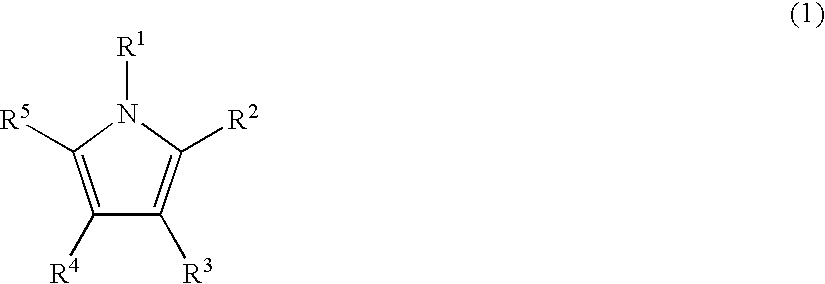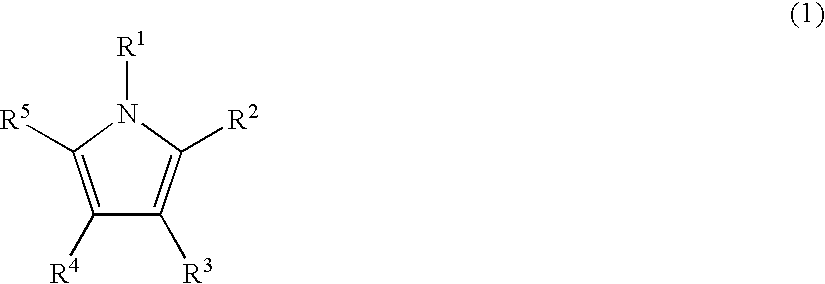Pyrrole derivative
- Summary
- Abstract
- Description
- Claims
- Application Information
AI Technical Summary
Benefits of technology
Problems solved by technology
Method used
Image
Examples
reference example 1
Preparation for (1H-pyrrol-2-yl)(4-methylphenyl)ketone
reference example 1-1
Preparation for (1-benzenesulfonyl-1H-pyrrol-2-yl)(4-methylphenyl)ketone
[0843] 65
[0844] To a solution of 1-benzenesulfonyl-1H-pyrrole (284 g, 1.37 mol) in dichloromethane (1.0 L) were added p-toluoyl chloride (318 g, 2.06 mol) and boron trifluoride-diethyl ether (350 g, 2.47 mol) under an atmosphere of nitrogen. The mixture was allowed to stand at room temperature for 7 days. The reaction solution was washed with 1N hydrochloric acid (750 ml) twice, an aqueous 1N sodium hydroxide solution (750 ml) and a saturated aqueous sodium chloride solution (100 ml) in the order, dried and filtered. The filtrate was further concentrated to about 500 ml at atmospheric pressure, followed by addition of hexane (500 ml). Further the solution was concentrated to about 500 ml and cooled to 10.degree. C. The precipitate was filtered, washed with hexane and toluene in the order, and dried to give the subject compound (315 g, 71%).
[0845] .sup.1H NMR (CDCl.sub.3, 300 MHz) .delta. 8.12 (d, 2H, J=8.3 Hz), ...
reference example 1-2
Preparation for (1H-pyrrol-2-yl)(4-methylphenyl)ketone
[0846] 66
[0847] The compound (145 g, 446 mol) prepared by Reference example 1-1 was suspended in methanol (1.0 L) and thereto was added an aqueous 5N sodium hydroxide solution (1.1 kg). The mixture was refluxed under heating for 30 min. and then gradually cooled to 0.degree. C. The precipitate was collected by filtration and dried to give the subject compound (80 g, 97%).
[0848] .sup.1H NMR (CDCl.sub.3, 300 MHz) .delta. 9.52 (brs, 1H), 8.25 (d, 2H, J=8.3 Hz), 7.29 (d, 2H, J=8.3 Hz), 7.12 (brs, 1H), 6.88-6.91 (m, 1H), 6.32-6.36 (m, 1H), 2.44 (s, 3H).
PUM
| Property | Measurement | Unit |
|---|---|---|
| Fraction | aaaaa | aaaaa |
| Fraction | aaaaa | aaaaa |
| Fraction | aaaaa | aaaaa |
Abstract
Description
Claims
Application Information
 Login to View More
Login to View More - R&D
- Intellectual Property
- Life Sciences
- Materials
- Tech Scout
- Unparalleled Data Quality
- Higher Quality Content
- 60% Fewer Hallucinations
Browse by: Latest US Patents, China's latest patents, Technical Efficacy Thesaurus, Application Domain, Technology Topic, Popular Technical Reports.
© 2025 PatSnap. All rights reserved.Legal|Privacy policy|Modern Slavery Act Transparency Statement|Sitemap|About US| Contact US: help@patsnap.com



